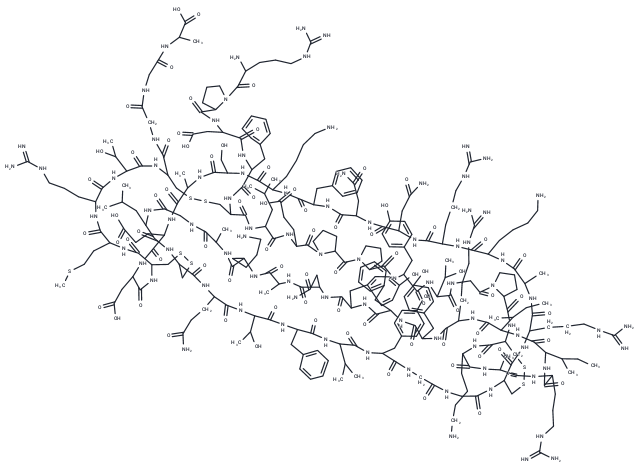Shopping Cart
Remove All Your shopping cart is currently empty
Your shopping cart is currently empty
Aprotinin (Traskolan) is a broad-spectrum serine protease (BPTI) inhibitor that inhibits the activity of a number of different esterases and proteases. Aprotinin is an antifibrinolytic agent used to minimize hemorrhage during complex surgical procedures.

| Pack Size | Price | USA Warehouse | Global Warehouse | Quantity |
|---|---|---|---|---|
| 5 mg | $39 | In Stock | In Stock | |
| 10 mg | $54 | In Stock | In Stock | |
| 25 mg | $117 | In Stock | In Stock | |
| 50 mg | $198 | In Stock | In Stock | |
| 100 mg | $328 | In Stock | In Stock | |
| 200 mg | $493 | In Stock | In Stock | |
| 500 mg | $789 | In Stock | - |
| Description | Aprotinin (Traskolan) is a broad-spectrum serine protease (BPTI) inhibitor that inhibits the activity of a number of different esterases and proteases. Aprotinin is an antifibrinolytic agent used to minimize hemorrhage during complex surgical procedures. |
| Targets&IC50 | Trypsin:0.06 pM (Kd), Kallikrein:0.8 nM (Kd), Trypsinogen:2 μM (Kd), Chymotrypsin:9.5 nM (Kd) |
| In vitro | METHODS: SARS-CoV-2 infected Caco2 cells were treated with Aprotinin (0-20 µM) for 48 h and cytopathic effect (CPE) was detected.
RESULTS: Aprotinin showed antiviral effects on CPE formation in SARS-CoV-2 infected Caco2 cells with an IC50 range of 0.81 µM-1.03 µM. [1] METHODS: VSMCs cells were pretreated with Aprotinin (1-100 µM) for 1 h, treated with cytokines (10 ng/mL IL-1β+25 ng/ml TNF-α) for 12 h, and then the target gene and protein expression levels were detected by Western Blot and RT-PCR. RESULTS: Aprotinin stimulated a significant increase in HO-1 protein levels and mRNA levels with cytokines in a concentration-dependent manner. [2] |
| In vivo | METHODS: To study in vivo anti-influenza virus activity, Aprotinin (2 mg/kg) was administered intravenously twice daily for 5 days to lethally A/PR/8/34 (H1N1) virus-infected C57BL/6 mice.
RESULTS: Aprotinin alone did not cause weight loss in mice, and the survival rate of PBS-treated mice was 0% at 8 days post-infection. Meanwhile, the group of mice treated with Aprotinin showed a 75% survival rate. [3] |
| Kinase Assay | Substrates and kinases are diluted in 50?mM Tris/HCl (pH?7.5), 0.1% 2-mercaptoethanol, 0.1?mM EGTA and 10?mM magnesium acetate. Reactions are initiated with [γ-32P]ATP (2500 c.p.m./pmol) to a final concentration of 0.1?mM and terminated after 15?min at 30°C by the addition of SDS and EDTA (pH?7.0) to final concentrations of 1.0% (w/v) and 20?mM respectively. After heating for 5?min at 100°C and separation by SDS/PAGE, the phosphorylated proteins are detected by autoradiography. |
| Cell Research | Mouse G8-1 myoblasts are plated DMEM + 20% FBS (maintenance medium), in which they remain undifferentiated. When cells reach approximately 40-50% confluence, different protease inhibitors are added to the culture media and cells are incubated overnight. Cells are then switched to differentiation-promoting media (DMEM + 10% horse serum ± protease inhibitor) and incubated for 7 days. (Only for Reference) |
| Synonyms | Traskolan, Bovine Pancreatic Trypsin Inhibitor, Antilysin |
| Molecular Weight | 6511.51 |
| Formula | C284H432N84O79S7 |
| Cas No. | 9087-70-1 |
| Smiles | CCC(C)C1NC(=O)C(CCCNC(N)=N)NC(=O)C(C)NC(=O)C(CCCCN)NC(=O)C2CSSCC3NC(=O)CNC(=O)CNC(=O)C(Cc4ccc(O)cc4)NC(=O)C(NC(=O)C(Cc4ccccc4)NC(=O)C(NC(=O)C(CCC(N)=O)NC(=O)C(CSSCC(NC(=O)C(CC(O)=O)NC(=O)C(CCC(O)=O)NC(=O)C(C)NC(=O)C(CO)NC(=O)C(CCCCN)NC(=O)C(Cc4ccccc4)NC(=O)C(CC(N)=O)NC(=O)C(CC(N)=O)NC(=O)C(CCCNC(N)=N)NC(=O)C(CCCCN)NC(=O)C(C)NC(=O)C(CCCNC(N)=N)NC3=O)C(=O)NC(CCSC)C(=O)NC(CCCNC(N)=N)C(=O)NC(C(C)O)C(=O)NC(CSSCC(NC(=O)C(Cc3ccccc3)NC(=O)C(CC(O)=O)NC(=O)C3CCCN3C(=O)C(N)CCCNC(N)=N)C(=O)NC(CC(C)C)C(=O)NC(CCC(O)=O)C(=O)N3CCCC3C(=O)N3CCCC3C(=O)NC(Cc3ccc(O)cc3)C(=O)NC(C(C)O)C(=O)NCC(=O)N3CCCC3C(=O)N2)C(=O)NCC(=O)NCC(=O)NC(C)C(O)=O)NC(=O)C(CC(C)C)NC(=O)CNC(=O)C(C)NC(=O)C(CCCCN)NC(=O)C(C)NC(=O)C(CC(N)=O)NC(=O)C(Cc2ccc(O)cc2)NC(=O)C(Cc2ccccc2)NC(=O)C(Cc2ccc(O)cc2)NC(=O)C(CCCNC(N)=N)NC(=O)C(NC1=O)C(C)CC)C(C)O)C(C)C |
| Relative Density. | no data available |
| Color | White |
| Appearance | Solid |
| Sequence | Arg-Pro-Asp-Phe-Cys-Leu-Glu-Pro-Pro-Tyr-Thr-Gly-Pro-Cys-Lys-Ala-Arg-Ile-Ile-Arg-Tyr-Phe-Tyr-Asn-Ala-Lys-Ala-Gly-Leu-Cys-Gln-Thr-Phe-Val-Tyr-Gly-Gly-Cys-Arg-Ala-Lys-Arg-Asn-Asn-Phe-Lys-Ser-Ala-Glu-Asp-Cys-Met-Arg-Thr-Cys-Gly-Gly-Ala(Disulfide bridge: Cys5- |
| Sequence Short | RPDFCLEPPYTGPCKARIIRYFYNAKAGLCQTFVYGGCRAKRNNFKSAEDCMRTCGGA(Disulfide bridge: Cys5-Cys55,Cys14-Cys38,Cys30-Cys51) |
| Storage | keep away from moisture | Powder: -20°C for 3 years | In solvent: -80°C for 1 year | Shipping with blue ice/Shipping at ambient temperature. | |||||||||||||||||||||||||
| Solubility Information | H2O: 242.5 mg/mL (37.24 mM), Sonication is recommended. | |||||||||||||||||||||||||
Solution Preparation Table | ||||||||||||||||||||||||||
H2O
| ||||||||||||||||||||||||||
| Size | Quantity | Unit Price | Amount | Operation |
|---|

Copyright © 2015-2025 TargetMol Chemicals Inc. All Rights Reserved.